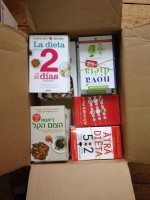Are you doing the 5:2 diet? The 500 calorie fast days are obviously the hardest part of the diet – how on earth are you supposed to survive on just 500 calories all day? It can be done.
The point of the 5:2 diet is that you give your body 2 fast days and 5 days where you eat normally, albeit slightly healthier. The diet is fast becoming the nation’s favourite weight-loss option and the fast days needn’t be as scary as they sound.
We’re not saying they’re not going to be hard but if you plan your day throughly you can make sure they’re as easy as they possibly can be.
We’ve collected (website http://www.goodtoknow.co.uk/recipes/538311/5-2-diet-meal-plans-what-to-eat-for-500-calorie-fast-days) together calorie-counted recipes and ideas for breakfast (under 100 calories), lunch (under 200 calories), dinner (under 200-300-400)and snacks (under 100 calories) so you can piece together a 500 calorie meal plan that suits you. Some people like to have one big meal, while others need to eat more frequently. Our meal planners below will show you how it’s done, then its over you. Pick from our breakfasts under 100 calories, lunches under 200 calories and dinners under 200, 300 and 400 calories to make the most out of your 500 calories.
I found this on the website http://www.goodtoknow.co.uk/recipes/538311/5-2-diet-meal-plans-what-to-eat-for-500-calorie-fast-days



2:03 am
17 Sep 14